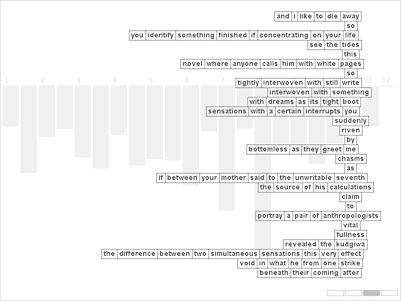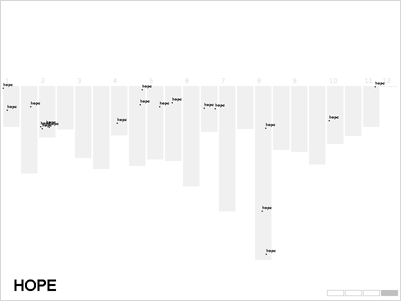| |

|
| |
| |

by Peter Cho
built with Calmap by Matt Dubord and Peter Cho
>> view the project
Code Calvino requires a Java-enabled browser.
|
| |

|
| |

|
This project is based on Italo Calvino's novel If on a Winter's Night a Traveller.
The chapters of the book are represented visually by columns as shown in the intro screen at left,
where the number of pixels of each column corresponds to the approximate number of words in each section.
Chapters with numbers are indicated.
Four buttons in the lower-right bring you to four different modes exploring
the text of the novel.
|
| |

|
| |

|
The first mode shows occurrences of the words 'reading' and 'writing' in the text.
When the user clicks on one of the two words, the context of an occurrence of the
selected word is brought to the foreground.
|
| |

|
| |

|
In the second mode, the software reconfigures the text, beginning by selecting a random word
from the first chapter. The software scans the text until it finds the next occurrence of the
selected word, then the word immediately following this occurrence is added to the text thread.
Then the new word becomes the next search term, and so forth.
(This technique was used in Claude Shannon's 1948 paper
"A Mathematical Theory of Communication," to construct a second-order
word approximation of English.)
|
| |

|
| |

|
The third mode begins with a sentence from chapter three of the novel. When the user
clicks on a word, the software randomly chooses a new word to follow from all
possible words which follow the highlighted word in the text.
|
| |

|
| |

|
The fourth mode calls out words from the novel that appear exactly nineteen times.
What is the reading of a text, in fact, except the recording of certain thematic
recurrences, certain insistences of forms and meanings? An electronic reading
supplies me with a list of the frequencies, which I have only to glance at to
form an idea of the problems the book suggests to my critical study. -p186
|
| |

|
| |
>> view the project
|





